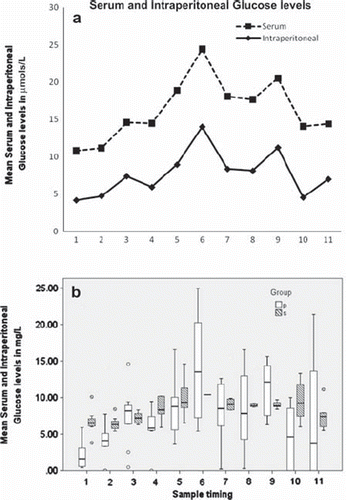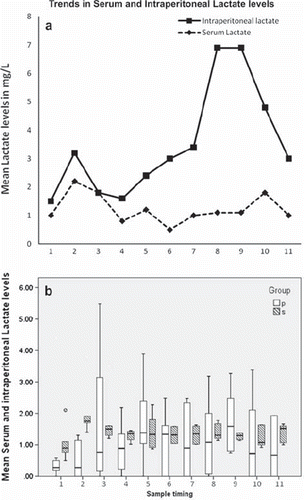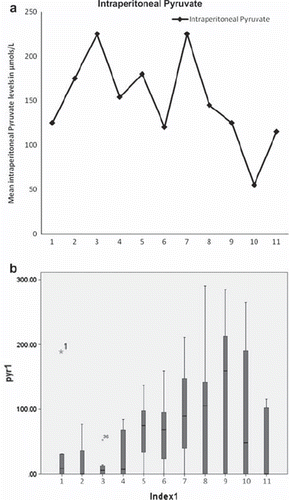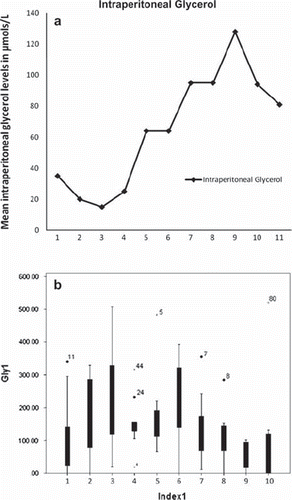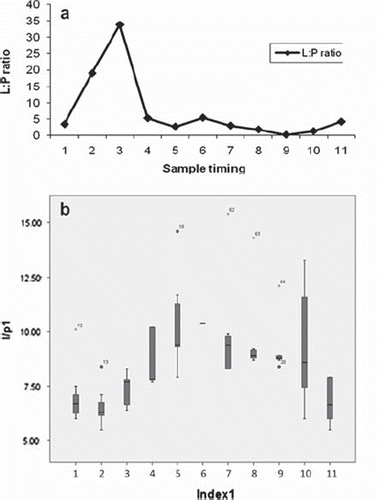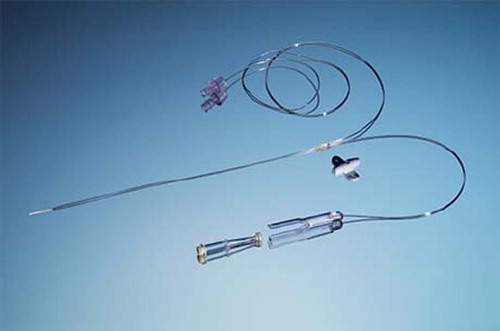Abstract
Objective. Splanchnic hypoxia, with resultant mucosal acidosis during cardiopulmonary bypass (CPB) has been demonstrated using tonometry. Microdialysis is a minimally-invasive method of obtaining peritoneal fluid samples. We measured the intraperitoneal metabolites during peri-operative period following hypothermic CPB and studied the safety of intraperitoneal microdialysis. Design. Eleven consecutive patients undergoing coronary artery bypass grafting (CABG) were included after obtaining ethics committee approval and informed consent. Microdialysis catheters were placed intraperitoneally after sternotomy. Intraperitoneal samples and arterial blood samples were obtained peri-operatively for first 24 hours. The samples were analysed for levels of glucose, lactate, pyruvate and glycerol. Repeated measures ANOVA test was used to compare timed serum and intraperitoneal samples. Results. The study population included nine males and two females with a mean age of 63.7 ± 11 years. The mean CPB and X clamp times were 50.9 ± 7.3 minutes and 27.3 ± 4.9 minutes, respectively. There were no complications related to microdialysis. The intraperitoneal lactate (L), pyruvate (P) and glycerol increased during CPB and four to six hours postoperatively. The L:P ratio was >10:1 during CPB, but in the postoperative period showed evidence of impaired oxygen utilisation. Conclusions. This prospective study confirms incidence of intraperitoneal anaerobic metabolism of glucose during CPB and impaired utilisation of glucose in the postoperative period. Microdialysis provides a novel and minimally-invasive method to measure real time intraperitoneal events.
A reduction in splanchnic blood flow occurs in the peri-operative period following cardiac surgery with or without cardiopulmonary bypass (CPB) (Citation1). The resultant hypoxia and reperfusion injury in the recovery phase has been hypothesised to contribute to the postoperative systemic inflammatory response (Citation2). Elevated levels of serum endotoxins (Citation3), increased gut permeability (Citation4) and increased levels of intraperitoneal inflammatory markers (Citation5) all support this hypothesis. Gastric tonometry (Citation6), hepatic venous oxygen saturation measurement (Citation7) and indocyanine green dye disappearance method (Citation8) have been used to demonstrate splanchnic hypoperfusion. However, these methods use indirect means to assess the incidence and the severity of splanchnic hypoxia, and have a lag period between the intraperitoneal events and their measurement.
In vivo microdialysis has emerged as a useful technique to measure the levels of extra-cellular fluid contents particularly metabolites of anaerobic metabolism of glucose. Microdialysis catheter has a double lumen catheter with a semi-permeable membrane at its end, which is placed in the tissue of choice and a balanced solution is perfused at a constant rate (Citation9). Following diffusion of molecules according to their concentration gradient the sample fluid is collected in micropipettes and analysed. Recent advances in chemical detectors (requiring microlitres of fluid for analysis) and miniaturisation of probe size made it possible for the catheters to be placed in different sites like subcutaneous tissues (Citation10), brain (Citation11), liver (Citation12), heart (Citation13) and muscle (Citation14). Samples can be obtained as timed samples and analysed or real time bedside monitoring can be performed by connecting the catheter to the analyser.
Based on the work of DeLaurier et al., which suggested that analysis of peritoneal fluid may be good marker of serious pathologic events (Citation15), researchers have seen a potential role for monitoring intraperitoneal events as markers of splanchnic hypoxia. It has been shown that serosal surfaces of gut are more vulnerable to direct chemical and bacterial insults in experimental peritonitis and sepsis (Citation16,Citation17). Consequently, measurements near serosa may be particularly sensitive at detecting occult hypoxia of gut. Experimental data on intraperitoneal microdialysis have suggested that early detection of intestinal ischaemia is possible using the lactate/pyruvate (L/P) ratio (Citation18). Previous human studies confirmed the safety and reliability of this method (Citation20). The aim of the present study was to investigate the role of intraperitoneal microdialysis to assess the incidence and severity of anaerobic metabolism consequent to gut hypoxia in the immediate postoperative period following CPB. Intraperitoneal lactate, pyruvate, glycerol levels were measured and intraperitoneal L/P ratio was monitored to assess the severity of splanchnic hypoxia.
Material and methods
Protocol
We obtained the local ethics committee approval for this prospective observational study. Eleven consecutive patients with good or moderate left ventricular function undergoing elective or urgent coronary artery bypass grafting (CABG) were included in the study after obtaining informed consent. All patients had a similar anaesthetic, operative and perfusion protocol. Patients with impaired liver and renal function, patients on steroids and other anti-inflammatory medications, poor left ventricular function, those undergoing emergency procedures, or had previous abdominal surgery and those requiring inotropes or intra-aortic balloon pump either pre or postoperatively were excluded from the study. Medication like angiotensin-converting enzyme (ACE) inhibitors and calcium channel blockers were avoided on the day of operation. Following induction of general anaesthesia and median sternotomy a small incision was made in the central tendon of diaphragm and microdialysis catheter introduced into the peritoneal cavity under vision. The defect in the diaphragm was closed immediately. The catheter was positioned to remain in the upper abdomen, as hypoxia involves whole of splanchnic bed the position of catheter was deemed inconsequential (Citation21). Samples were obtained at 20-minute intervals intra-operatively and at two hourly intervals in the postoperative period. The first washout sample was discarded and a pre-bypass sample obtained, followed by two samples during CPB and one sample around the time of protamine administration. Following return to the intensive care unit (ICU) further samples were obtained at two hourly intervals. Simultaneous arterial blood gas samples were obtained.
Anaesthetic protocol
General anaesthesia was induced using intravenous Fentanyl at a dose of 15–20 μg/kg and Propofol at a dose of 0.5 mg/kg and was maintained with Isoflurane at an end tidal concentration of 0.5–1.0% and Propofol infusion at 2–3 mg/kg/hr. Muscle relaxation was achieved using Pancuronium 0.1 mg/kg. Central venous pressure and arterial pressure monitoring was performed peri-operatively.
Perfusion protocol
Cardiopulmonary bypass circuit was constructed using a hollow fibre oxygenator Jostra Oxygenator (Maquet inc., New Jersey, USA), a Stockert roller pump set – S3, a Quart (Jostra) Arterial Filter (Macquet Inc., New Jersey, USA) Arterial filter. All patients were commenced on bypass using a two staged atrial cannula (Medtronic) and an aortic cannula (DLP-Medtronic). A temperature of 28°C was aimed for when cooling the patients. Flow rate was maintained at 2.4 l/min/m2 during normothermia and was reduced to 1.8 l/min/m2 when the target core temperature of 28°C was achieved. Following commencement of bypass and application of aortic cross clamp antegrade intermittent cold blood cardioplegia (Harefield formula cardioplegia solution) was delivered at regular intervals of 20 minutes. An alpha stat method was used to maintain the pH and acid base status of the patient. During CPB, the mean arterial pressure was maintained at 55–70 mmHg and hematocrit at 20–25%.
Microdialysis
The microdialysis catheter is a thin, double lumen, concentric plastic tube with a 30 mm semi-permeable tubular membrane (cut-off pore size at 20 000 Dalton) at its distal end.
Through an incision in the diaphragm the catheter was introduced intraperitoneally and brought to the surface through the skin (like an epicardial pacing wire). The CMA 62 gastrointestinal catheter with 210 mm shaft and 30 mm membrane (CMA Microdialysis, Stockholm, Sweden) was used. A physiological fluid (T1 – CMA Microdialysis AB, Stockholm, Sweden: Na – 147 mmol; K – 4 mmol; Ca – 2.3 mmol; Cl – 156 mmol; pH – 6) was pumped with a speed of 0.2 μl/min from a CMA 106 microdialysis pump (CMA Microdialysis AB, Stockholm, Sweden). The fluid flows through the outer tube of the catheter and flows underneath the membrane, where the exchange between the intraperitoneal fluid and perfusion fluid takes place. At the tip, the fluid flows through a small hole into the inner tube and is finally collected in a microvial, for future analysis. The dialysate was analysed for glucose, pyruvate, lactate and glycerol using CMA 600 Microdialysis analyser (CMA Microdialysis AB, Stockholm, Sweden).
Statistical analysis
The current study is a pilot study to quantify the extent of anaerobic metabolism as a consequence of splanchnic hypoxia, hence power calculation was not performed. Serum and intraperitoneal levels of metabolites were compared using repeated measures ANOVA test. SPSS software (SPSS inc. USA) version-15 was used for statistical analysis.
Results
The study population consisted of nine males and two females with mean age of 63.7 ± 11 years (median 64 and range of 62–68 years) (). The mean body surface area was 1.91 ± 0.09 m2. Nine patients had good left ventricular (LV) function and two had moderate LV function. The mean CPB time was 50.9 ± 7.3 minutes and the mean aortic cross clamp time was 27.3 ± 4.9 minutes. The mean temperature to which patients were cooled was 29.56 ± 1.3°C. The average number of grafts that were performed were 2.8 ± 0.2 (median 3 and range of 2–4). There were no complications related to the insertion of and removal of the microdialysis catheters. None of the patients required inotropic support or vasoconstrictors in the postoperative period. One patient's recovery was complicated with atrial fibrillation, which was treated medically.
Table I. Demographic and operative details of the study group.
Comparison of the trends in the serum and intraperitoneal levels of glucose showed lower intraperitoneal glucose levels before CPB, which then equalled the serum levels during CPB, however, in the postoperative period the intraperitoneal glucose levels doubled (up to 19 mmol/l) (p = 0.032) when compared to serum levels (). All patients were treated with insulin infusions (following a standard sliding scale) to keep blood glucose levels in the physiological range (7.0–9.0 mmol/l).
Serum lactate levels were higher than intraperitoneal lactate levels before and during CPB (). However, the intraperitoneal levels started increasing four to eight hours postoperatively, about two hours after corresponding peak of intraperitoneal glucose levels. The intraperitoneal lactate levels increased up to a mean of 2.0 mmol/l during CPB, but subsequently increased to 6.0 mmol/l (six times that of corresponding serum levels) (p = 0.043). The serum lactate levels remained relatively stable (0.5–1.0 mmol/l) with little elevation during CPB and postoperative periods.
The intraperitoneal levels of pyruvate decreased during CPB, but increased to a mean 125 μmol/l during the postoperative period, with peak levels reaching eight hours after CPB, corresponding to the peak lactate levels (). The intraperitoneal levels of glycerol increased to a mean value of 260 μmol/l during CPB and to a mean value of 220 μmol/l in the postoperative period (). The corresponding serum pyruvate and glycerol could not be measured for comparison, due to non-availability of analysing apparatus. The normal intraperitoneal levels and the highest levels following CPB are shown in .
Table II. Normal values, of intraperitoneal and subcutaneous microdialysis in measurements of lactate/pyruvate ratio, glucose and glycerol. (reproduced with permission from Jansson et al. (Citation29))
The lactate to pyruvate ratio normally is less than 10:1, however a ratio of >10:1 suggests that oxygen delivery is inadequate to meet metabolic demand, whereas an increase in both lactate and pyruvate with preservation of normal lactate:pyruvate ratio suggests a defect in oxygen utilisation despite adequate oxygen supply (Citation22). The L:P ratio during CPB increased to >30:1 where as the ratio returned to normal range (<10:1) despite the elevated lactate and pyruvate levels in the peritoneal cavity during the postoperative period ().
Discussion
Intraperitoneal microdialysis, which was first tested in pigs, (Citation19) has currently emerged as an important research and clinical tool to monitor early ischaemic changes following neurosurgical procedures, plastic surgical procedures involving muscle flap reconstructions, liver transplant and bowel anastamosis. The current study is the first where microdialysis has been used to monitor products of anaerobic metabolism intraperitoneally following cardiac surgery.
The principle of microdialysis is to mimic a capillary. The catheter is perfused with an isotonic ringer solution. Metabolites from the tissue diffuse across the dialysis membrane into the perfusion fluid, which is collected for bedside analysis. The substances measured in the perfusate reflect both the metabolism of the tissues and substances delivered to the tissue from the blood. Depending on the size of the pores in the semi-permeable membrane various substances such as gut hormones, inflammatory cytokines can be measured in real time.
The principle findings of the current study are that:
a) anaerobic metabolism of glucose occurs during hypothermic CPB reflecting an impaired oxygen delivery;
b) impaired oxygen utilisation occurs in the postoperative period represented by normal L:P ratio but elevated levels of lactate and pyruvate;
c) elevated glycerol levels during CPB indicate mucosal cellular damage.
CPB is associated with a reduction of splanchnic and renal blood flow due to a combination of hypothermia and non-pulsatile flow. The hypoxic state consequent to hypo-perfusion leads to mucosal damage, increased mucosal permeability, release of endotoxins and contribute to the postoperative systemic inflammatory response.
Impaired blood flow results in a decrease in oxygen delivery, which forces the tissue to switch to anaerobic metabolism, with a resultant increase in tissue lactate. Lactate is the end product of anaerobic metabolism and is in dynamic equilibrium with its precursor pyruvate (maintaining a ratio of L:P of <10:1). Lactate alone is not a good marker of anaerobic metabolism secondary to hypoxia, because an increase in lactate could result from increased metabolism, hence L:P ratio is a good indicator of ischemia (Citation23,Citation24). If supply of oxygen is insufficient and anaerobic conditions continue to prevail, the pyruvate will decrease resulting in an increase in L:P ratio (L:P ratio >10:1) suggesting that oxygen delivery is inadequate to meet the metabolic demand of tissue. Whereas increases in both lactate and pyruvate values with preservation of normal lactate/pyruvate ratio suggest a defect in oxidative utilisation, despite adequate oxygen supply (due to increase in the inactive form of pyruvate dehydrogenase enzyme complex).
The timing of elevation of lactate and pyruvate indicate that during hypothermic cardiopulmonary bypass, the splanchnic perfusion remains inadequate and the organs switch to anaerobic metabolism, marked by elevation of lactate and pyruvate. Following removal of cross clamp and rewarming, a reperfusion phase begins that lasts for four to six hours in the postoperative period. This phenomenon was demonstrated in studies using gastric tonometry. The impaired utilisation of oxygen during the postoperative period could be the result of reperfusion injury (secondary to oxygen free radicals etc.), where the gut mucosal cells are unable to resume their normal aerobic metabolism despite adequate oxygen supply.
Glycerol is a marker of cell membrane damage (Citation25–28). When a cell degenerates, the phospholipids of the cell membrane are degraded by phospholipases, resulting in release of fatty acids and glycerol. Intraperitoneal glycerol levels increased more during CPB than in the postoperative period suggesting cellular damage during hypoxia during CPB. Riddington et al. (Citation3), have demonstrated the form of increased intestinal permeability which is a reflection of cell membrane damage (Citation7).
Limitations
The number of patients in this study is small, limiting the conclusions that can be drawn, however, this study confirms that microdialysis is a safe research tool. Comparison with other established tools like tonometry was not performed, because the aim of the study was to assess feasibility. Future studies can be aimed at comparing splanchnic events in patients undergoing normothermic bypass or off-pump CABG (OPCAB) versus hypothermia. The principle aim of this study was to confirm the safety of intraperitoneal microdialysis in the setting of cardiac surgery.
Conclusions
The findings of this study confirm that anaerobic metabolites are released intraperitoneally during hypothermic CPB, which could be reflection of hypoxia secondary to hypoperfusion. This intra-operative hypoxic state is followed by a reperfusion phase characterised by impaired utilisation of oxygen in the postoperative period, which can lead to impaired gut function. Microdialysis provides a real time continuous method of monitoring intraperitoneal metabolites. Microdialysis has the potential to be used in measuring intraperitoneal levels of various gut hormones, inflammatory markers, endotoxins, etc. The real time information obtained thus can be used to modify management and confirm the improvement following intervention. We conclude that microdialysis is safe and can play a key role in understanding splanchnic perfusion in future studies.
Acknowledgements
A few of the Microdialysis catheters were supplied from CMA Microdialysis however most have been purchased. CMA Microdialysis AB did not sponsor the study. This study was presented at the international conference on Microdialysis, Cambridge, UK. The authors report no conflicts of interest. The authors alone are responsible for the content and writing of the paper.
References
- Kumle B, Boldt J, Suttner SW, Piper SN, Lehmann A, Blome M. Influence of prolonged cardiopulmonary bypass times on splanchnic perfusion and markers of splanchnic organ function. Ann Thorac Surg. 2003;75:1558–64.
- Ohri SK. Systemic inflammatory response and the splanchnic bed in cardiopulmonary bypass. Perfusion. 1996;11: 200–12.
- Jansen NJ, van Oeveren W, Gu YJ, Vliet MH, Eijsman L, Wildevuur CR. Endotoxin release and tumor necrosis factor formation during cardiopulmonary bypass. Ann Thorac Surg. 1993;55:1278–9.
- Riddington DW, Venkatesh B, Boivin CM, Bonser RS, Elliott SJ, Marshall T, . Intestinal permeability, gastric intramucosal pH, systemic endotoxemia in patients undergoing cardiopulmonary bypass. JAMA. 1996;275:1007–12.
- Jansson K, Redler B, Truedsson L, Magnuson A, Matthiessen P, Andersson M, . Intraperitoneal cytokine response after major surgery: Higher post-operative intraperitoneal versus systemic cytokine levels suggest the gastrointestinal tract as the major source of post-operative inflammatory reaction. Am J Surg. 2004;187:372–7.
- Ohri SK, Becket J, Brannan B, Keogh BE, Taylor KM. Effects of cardiopulmonary bypass on gut blood flow, oxygen utilisation, and intramucosal pH. Ann Thorac Surg. 1994;57: 1193–9.
- Okano N, Hiraoka H, Owada R, Fujita N, Kadoi Y, Saito S, . Hepatosplanchnic oxygenation is better preserved during mild hypothermic than during normothermic cardiopulmonary bypass. Can J Anaesth. 2001;48;1011–4.
- Chetty G, Sharpe DAC, Nandi J, Butler SJ, Mitchell IM. Liver blood flow during cardiac surgery. Perfusion. 2004;19: 153–6.
- Tisdall MM, Smith M. Cerebral microdialysis: Research technique or clinical tool. Br J Anaesth. 2006;97:18–25.
- Bahlmann L, Wagner K, Heringlake M, Wirtz C, Fütterer T, Schmucker P, . Subcutaneous microdialysis for metabolic monitoring in abdominal aortic surgery. J Clin Monit Comput. 2002;17:309–12.
- Nilsson OG, Brandt L, Ungerstedt U, Saveland H. Bedside detection of brain ischemia using intracerebral microdialysis: Subarachnoid haemorrhage and delayed ischemic deterioration. Neurosurgery. 1999;45:1176–84.
- Nowak G, Ungerstedt J, Wernerman J, Ungerstedt U, Ericzon BG. Clinical experience in continuous graft monitoring with microdialysis early after liver transplantation. Br J Surg. 2002;89:1169–75.
- Kennergren C, Mantovani V, Lonnroth P, Nyström B, Berglin E, Hamberger A. Monitoring of extracellular aspartate aminotransferase and troponin T by microdialysis during and after cardioplegic heart arrest. Cardiology. 1999;92:162–70.
- Lundberg G, Wahlberg E, Swedenborg J, Sundberg C J, Ungerstedt U, Olofsson P. Continuous assessment of local metabolism by microdialysis in critical limb ischemia. Eur J Vasc Endovasc Surg. 2000;19:605–13.
- DeLaurier GA, Ivey RK, Johnson RH. Peritoneal fluid lactic acid and diagnostic dilemmas in acute abdominal disease. Am J Surg. 1994;167:302–5.
- Hiltebrand LB, Krejci V, tenHoeval ME, Banic A, Sigurdsson GH. Redistribution of microcirculatory blood flow within the intestinal wall during sepsis and general anaesthesia. Anaesthesiology. 2003;98:658–69.
- Revelly JP, Ayuse T, Brienza N, Fessler HE, Robotham JL. Endotoxic shock alters distribution of blood flow within the intestinal wall. Crit Care Med. 1996;24:1345–51.
- Ungerstedt J, Nowak G, Ericzon BG, Ungerstedt U. Intraperitoneal microdialysis (IPM): A new technique for monitoring intestinal ischemia studied in a porcine model. Shock. 2003;20:91–6.
- Soomer T, Larsen JF. Intraperitoneal and intraluminal microdialysis in the detection of experimental regional intestinal ischemia. Br J Surg. 2004;91:855–61.
- Jansson K, Ungerstedt J, Jonsson T, Redler B, Andersson M, Ungerstedt U, . Human intraperitoneal microdialysis: Increased lactate/pyruvate ratio suggests early visceral ischemia: A pilot study. Scand J Gastroenterol. 2003;38:1007–11.
- Jansson K, Strand I, Redler B, Magnuson A, Ungerstedt U, Norgen L. Results of intraperitoneal microdialysis depend on the location of the catheter. Scand J Clin Lab Invest. 2004;64:63–70.
- Landow L. Splanchnic lactate production in cardiac surgery patients. Crit Care Med. 1993;21:S84–91.
- Ungerstedt J, Nowak G, Ericzon B, Ungerstedt U. Intraperitoneal microdialysis, a new experimental technique for monitoring intestinal ischemia studied in a porcine model. Shock. 2003;20:91–6.
- Harken AH. Lactic acidosis. Surg Gynecol Obstet. 1976;142: 593–606.
- Cori CF. Mammalian carbohydrate metabolism. Physiol Rev. 1931;11:143.
- Bazan NG, Jr. Effects of ischemia and electroconvulsive shock on free fatty acid pool in the brain. Biochem Biophys Acta. 1970;218:1–10.
- Paschen W, van den Kerchoff W, Hossmann KA. Glycerol as an indicator of lipid degradation in bicuculline-induced seizures and cerebral ischemia. Metab Brain Dis. 1986;1:37–44.
- Marklund N, Salci K, Lewen A, Hillered L. Glycerol as a marker for post-traumatic membrane phospholipids degradation in rat brain. Neuroreport. 1997;8:1457–61.
- Jansson K, Jansson M, Andersson M, Magnuson A, Ungerstedt U, Norgen L. Normal values and differences between intraperitoneal and subcutaneous microdialysis in patients after non-complicated gastrointestinal surgery. Scan J Clin Lab Invest. 2005;65:273–82.

